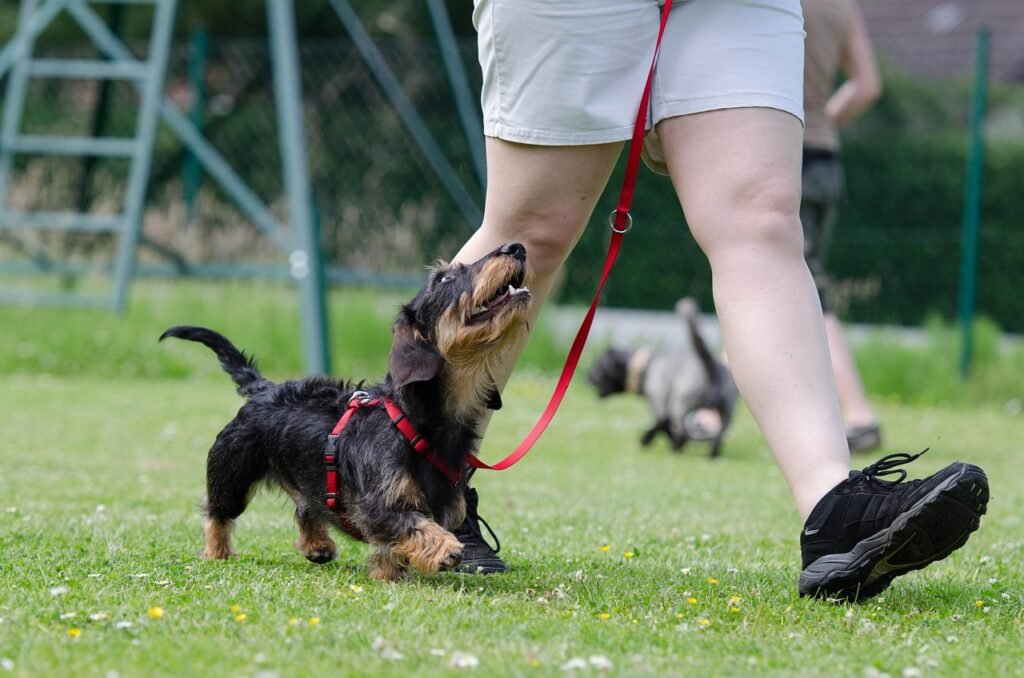
Effective Ways to Manage Separation Anxiety in Dogs
If you’ve ever experienced the heart-wrenching feeling of leaving your furry friend alone, only to come back to a house full of chewed up shoes and torn couch cushions, then you understand the wide range of emotions that separation anxiety in dogs can bring. Fortunately, there are effective ways to manage this common issue and help your four-legged companion feel more at ease when you’re not around. From creating a safe and comfortable environment to implementing gradual departures, this article explores practical strategies that will bring peace of mind to both you and your beloved pup.

This image is property of pixabay.com.
Find products like these on Amazon!
1. Understanding Separation Anxiety in Dogs
1.1 What is separation anxiety in dogs?
Separation anxiety in dogs is a condition that occurs when a dog becomes excessively anxious or stressed when left alone or separated from their owner. It is important to note that separation anxiety is not simply a case of boredom or loneliness, but rather a genuine fear that something bad will happen to their owner or themselves when they are apart. This anxiety can manifest in various destructive and disruptive behaviors such as excessive barking, destructive chewing, pacing, and even attempts to escape. Understanding the root cause of separation anxiety is crucial in order to effectively manage and support dogs suffering from this condition.
1.2 Signs and symptoms of separation anxiety
To identify if your dog may be struggling with separation anxiety, it is important to be aware of the common signs and symptoms. Some of the key indicators include excessive barking or howling, destructive chewing or scratching, urinating or defecating indoors (despite being house trained), attempting to escape from crates or rooms, pacing or restlessness, and even self-inflicted injuries. Dogs may exhibit these behaviors as soon as their owners begin to prepare to leave, or even after they have already departed. Recognizing these signs will enable you to intervene and provide the necessary support to alleviate your dog’s anxiety.
2. Preparing for Effective Separation Anxiety Management
2.1 Early socialization and training
Early socialization and training are crucial in preventing and managing separation anxiety in dogs. Introducing your puppy to various people, animals, and environments from a young age will help them become more confident and adaptable. Properly socialized dogs are less likely to develop separation anxiety as they have learned to trust that they can navigate different situations and environments without their owner’s constant presence. Additionally, comprehensive obedience training that focuses on commands such as “sit,” “stay,” and “come” can help establish a sense of structure and give your dog a sense of security.
2.2 Establishing a predictable routine
Creating a predictable routine is key to managing separation anxiety in dogs. Dogs thrive on consistency and knowing what to expect. By establishing a regular schedule for feeding, exercise, bathroom breaks, and playtime, your dog will feel more secure and less anxious. Consistency in routines helps to build a sense of stability and predictability, which is crucial in reducing separation anxiety. Plan your daily activities and ensure that you allocate dedicated time for exercise, mental stimulation, and quality bonding with your dog.
2.3 Creating a safe and comfortable environment
Providing a safe and comfortable environment is essential for dogs with separation anxiety. Ensure that your dog has a designated area or crate where they can retreat to when they feel anxious or overwhelmed. This safe space should be comfortable and include bedding, toys, and items that have your scent on them. The familiar smells and textures will help your dog feel secure when you are not around. Additionally, consider using calming products, such as plug-in diffusers that release dog-appeasing pheromones, to create a calming atmosphere in your home.
Find products like these on Amazon!
3. Effective Strategies for Dealing with Separation Anxiety
3.1 Gradual desensitization and counterconditioning
Gradual desensitization and counterconditioning are effective techniques for helping dogs overcome separation anxiety. The goal is to gradually increase the dog’s tolerance to being alone through a series of controlled exposures. Start by leaving your dog alone for short periods, such as a few minutes, and gradually increase the duration as they become more comfortable. During these periods, engage in a positive activity such as giving them a special treat or toy. This association between positive experiences and alone time can help your dog develop a more positive outlook on being separated from you.
3.2 Providing mental and physical stimulation
Keeping your dog mentally and physically stimulated can help prevent and alleviate separation anxiety. Mental stimulation can include puzzle toys, interactive games, and obedience training sessions. Physical exercise, such as daily walks, runs, or playtime, helps to release excess energy and promotes relaxation. A tired and stimulated dog is less likely to exhibit anxious behaviors when left alone. Incorporate a variety of activities into your daily routine to ensure your dog is both mentally and physically challenged.
3.3 Using positive reinforcement techniques
Positive reinforcement techniques are vital when managing separation anxiety in dogs. Reward your dog for calm and relaxed behavior during alone time, such as not barking or destroying items. Use treats, praise, and affection to reinforce the positive behavior. This positive association with being alone will gradually reduce their anxiety and build their confidence. Avoid scolding or punishing your dog for anxious behaviors, as this can heighten their anxiety and exacerbate the problem. Patience, consistency, and positivity are key when implementing positive reinforcement techniques.
4. Professional Help for Managing Separation Anxiety
4.1 Consultation with a veterinarian or animal behaviorist
If your dog’s separation anxiety is severe or persists despite your efforts, it may be beneficial to seek professional help. Consultation with a veterinarian or animal behaviorist who specializes in separation anxiety can provide valuable insights and guidance. They can help assess your dog’s specific needs, recommend further strategies, and potentially prescribe medication if necessary. These professionals have the expertise and experience to develop a personalized plan tailored to your dog’s unique situation.
4.2 Medication options for severe cases
In severe cases of separation anxiety, medication may be prescribed by a veterinarian to help manage the condition. Medications such as anti-anxiety drugs or selective serotonin reuptake inhibitors (SSRIs) can help reduce your dog’s anxiety and provide temporary relief. However, medication should be used in conjunction with behavior modification techniques, as it is not a standalone solution. The assistance of a professional is crucial in determining the appropriate medication and dosage for your dog.
4.3 Working with a professional dog trainer
Enlisting the help of a professional dog trainer can greatly benefit both you and your dog in managing separation anxiety. A trainer specializing in behavior modification can guide you through step-by-step techniques and provide support throughout the training process. They can also help you identify specific triggers for your dog’s anxiety and develop strategies to address them. Regular sessions with a trainer will ensure that you are consistently implementing effective techniques and making progress towards reducing separation anxiety.

This image is property of pixabay.com.
5. Tools and Aids to Assist in Separation Anxiety Management
5.1 Crate training as a safe space
Crate training can be a valuable tool in managing separation anxiety. Dogs are den animals by nature, and crates can provide them with a sense of security and a designated safe space. Introduce your dog to the crate gradually, using positive reinforcement techniques such as treats and praise. Make the crate comfortable by adding bedding and toys. When properly trained, your dog can retreat to their crate voluntarily, reducing anxiety and destructive behaviors while you are away.
5.2 Interactive toys and puzzles
Interactive toys and puzzles are excellent tools for keeping dogs mentally stimulated and distracted during alone time. These toys can help redirect their focus from separation anxiety to a challenging and engaging activity. Treat-dispensing toys or puzzle games that require problem-solving can be particularly effective. These toys can occupy your dog’s attention and reward them for calm and independent behavior.
5.3 Calming pheromone products
Calming pheromone products, such as plug-in diffusers and sprays, can help create a soothing environment for dogs with separation anxiety. These products release synthetic pheromones that mimic the natural calming scents produced by mother dogs to comfort their puppies. Placing a pheromone diffuser near your dog’s safe space or using a spray on their bedding can help reduce anxiety and promote relaxation. Calming pheromone products work in conjunction with other management techniques and can provide additional support for your dog during separation.
6. Strategies for Preventing Separation Anxiety in Puppies
6.1 Proper socialization during the critical period
Preventing separation anxiety in puppies starts with proper socialization during their critical development period, typically between 3 to 14 weeks of age. Expose your puppy to a wide range of people, animals, and environments in a positive and controlled manner. Introduce them to new experiences gradually, and ensure each experience is associated with positive reinforcement, such as treats and praise. This comprehensive socialization will help your puppy build confidence and adaptability, making them less prone to developing separation anxiety.
6.2 Gradual exposure to alone time
Gradual exposure to alone time is essential for preventing separation anxiety in puppies. Start by leaving your puppy alone for short periods, initially just a few minutes, and gradually increase the duration over time. Throughout these periods, provide them with engaging toys or puzzle games to keep them occupied and happy. By getting your puppy accustomed to being alone from an early age, they will learn that separation is a normal and safe part of their routine.
6.3 Avoiding reinforcement of anxious behaviors
Avoiding reinforcement of anxious behaviors is crucial when preventing separation anxiety in puppies. Resist the temptation to respond to excessive whining, barking, or destructive behavior with attention or reassurance. Instead, wait for a moment of calmness before rewarding or acknowledging them. This approach teaches puppies that calmness leads to positive outcomes, while anxious behaviors do not. Consistency in reinforcing positive behavior will help shape a confident and independent puppy.

This image is property of pixabay.com.
7. The Importance of Exercise in Managing Separation Anxiety
7.1 Regular physical exercise to reduce anxiety
Regular physical exercise plays a significant role in managing separation anxiety in dogs. A tired dog is generally more relaxed and less likely to exhibit anxious behaviors. Engage in daily activities such as walks, runs, or interactive play sessions to help your dog burn off excess energy. The release of endorphins through exercise promotes a sense of well-being and can help reduce anxiety levels. Make sure to tailor the exercise routine to suit your dog’s age, breed, and energy level.
7.2 Mental stimulation through training and games
In addition to physical exercise, providing mental stimulation is crucial for dogs with separation anxiety. Engaging your dog in training sessions, teaching them new tricks or obedience commands, helps redirect their focus and builds their confidence. Interactive games and puzzle toys that require problem-solving skills can also keep their minds occupied and provide a positive distraction during alone time. A combination of physical and mental stimulation is key in managing separation anxiety effectively.
7.3 Incorporating interactive play and walks
Incorporating interactive play and regular walks into your routine can significantly benefit dogs with separation anxiety. Interactive play, such as tug-of-war or fetch, strengthens the bond between you and your dog and reduces stress levels. Regular walks not only provide physical exercise but also offer an opportunity for your dog to explore their surroundings and mentally stimulate their senses. Aim for a balanced approach that encompasses both physical and mental stimulation to help manage your dog’s separation anxiety.
8. Managing Separation Anxiety in Adult Dogs
8.1 Behavior modification techniques
Behavior modification techniques are essential in managing separation anxiety in adult dogs. Gradual desensitization and counterconditioning, as discussed earlier, can still be effective for adult dogs. Slowly expose your dog to periods of alone time, incorporating positive experiences and rewards as they remain calm and relaxed. Additionally, consider seeking the help of a professional dog trainer or behaviorist to develop a tailored behavior modification plan for you and your dog.
8.2 Establishing a departure routine
Establishing a departure routine can help alleviate anxiety in adult dogs. Dogs thrive on structure and routine, so creating a consistent departure ritual can provide them with a sense of security. Develop a series of predictable actions, such as preparing a puzzle toy, giving them a treat, and calmly saying goodbye. By consistently following the same routine, your dog will associate these cues with your departure, reducing their anxiety and providing a sense of predictability.
8.3 Monitoring progress and adjusting strategies
When managing separation anxiety in adult dogs, it is important to monitor progress and be prepared to adjust strategies if necessary. Every dog is unique, and what works for one may not work for another. Regularly assess your dog’s behaviors and reactions during alone time. If certain techniques are not proving effective, consult with a professional to modify your approach. Remember, managing separation anxiety requires patience, consistency, and ongoing assessment to ensure the best outcome for your dog.
9. Addressing Separation Anxiety in Rescue Dogs
9.1 Patient and consistent approach
Rescue dogs often have a history of abandonment or trauma, making them particularly prone to separation anxiety. Addressing separation anxiety in rescue dogs requires a patient and consistent approach. It is essential to establish trust and build a positive association with being alone over time. Allow your rescue dog to adjust to their new environment at their own pace and gradually introduce periods of separation, always accompanied by positive reinforcement and rewards for calm behavior.
9.2 Building trust and a sense of security
Building trust and a sense of security is vital when working with rescue dogs experiencing separation anxiety. Spend quality bonding time with your dog, engaging in activities that they enjoy. Regularly offer treats, praise, and affection to reinforce positive behaviors. By consistently providing a loving and supportive environment, you can help your rescue dog develop confidence and trust in themselves and in you.
9.3 Gradual exposure to new environments
Rescue dogs may be particularly sensitive to new environments, which can exacerbate separation anxiety. Gradual exposure to new environments can help alleviate their anxiety and increase their confidence. Start with short trips or visits to unfamiliar places and gradually increase the duration and complexity of the outings. Be patient and supportive during these experiences, providing reassurance and positive reinforcement. Over time, your rescue dog will become more comfortable and adapt to new environments with reduced anxiety.
10. Creating a Supportive Environment for Dogs with Separation Anxiety
10.1 Maintaining a calm and positive atmosphere
Maintaining a calm and positive atmosphere in your home is crucial for dogs with separation anxiety. Dogs are highly attuned to their owner’s emotions, so it is important to project a sense of calmness and confidence. Avoid showing signs of stress or anxiety when leaving or returning home, as this can trigger your dog’s anxiety. Instead, remain calm and composed, and greet your dog calmly when you return. By creating a serene environment, you can help your dog feel more secure even when you are not present.
10.2 Providing comfort and security through bedding and toys
Providing comfort and security through bedding and toys can greatly benefit dogs with separation anxiety. Give your dog access to soft and cozy bedding in their designated safe space, as it provides a comforting and familiar scent. Including their favorite toys or interactive puzzles can help keep them entertained and relaxed during alone time. Comfort items act as a source of emotional support, promoting a sense of security and reducing anxiety.
10.3 Avoiding punishment or negative reinforcement
It is crucial to avoid punishment or negative reinforcement when managing separation anxiety in dogs. Punishing your dog for anxious behaviors will only heighten their anxiety and worsen the problem. Instead, focus on positive reinforcement by rewarding calm and independent behavior. Make sure to use patient and gentle guidance to redirect any anxious behaviors. A supportive and loving approach is essential in creating a secure environment for your dog to overcome separation anxiety.
In conclusion, separation anxiety in dogs is a complex condition that requires comprehensive management strategies. By understanding the signs and symptoms of separation anxiety, preparing for effective management, seeking professional help when needed, and creating a supportive environment, you can help your dog overcome this challenging condition. Remember, patience, consistency, and positive reinforcement are key in helping your four-legged friend feel secure and comfortable when left alone. With your love and support, your dog can thrive and enjoy a fulfilled life, free from the constraints of separation anxiety.
Find products like these on Amazon!
- 1. Understanding Separation Anxiety in Dogs
- 2. Preparing for Effective Separation Anxiety Management
- 3. Effective Strategies for Dealing with Separation Anxiety
- 4. Professional Help for Managing Separation Anxiety
- 5. Tools and Aids to Assist in Separation Anxiety Management
- 6. Strategies for Preventing Separation Anxiety in Puppies
- 7. The Importance of Exercise in Managing Separation Anxiety
- 8. Managing Separation Anxiety in Adult Dogs
- 9. Addressing Separation Anxiety in Rescue Dogs
- 10. Creating a Supportive Environment for Dogs with Separation Anxiety



-
-
2 hours
Tagged Anxiety relief, Crate training, Dog training, Pet care